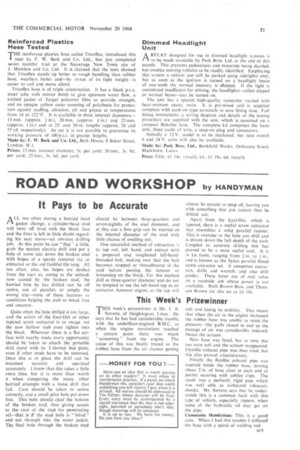It Pays to be Accurate
Page 53

If you've noticed an error in this article please click here to report it so we can fix it.
ALL too often during a 'hurried head gasket change, a cylinder-head stud will twist off level with the block face and the fitter isleft in little doubt regarding his next move—an obvious drilling job. At this point he can " flap " a little, grab the nearest electric drill and put a bole of some size down the broken stud with hopes of a speedy removal via an extractor or the old faithful file tang. All too often, also, his hopes are dashed from the start as, owing to the setback now caused by the broken stud, the hurried hole he has drilled can be off centre, out of parallel, or simply the wrong size—none of these features cr conditions helping the stub to break free and unscrew.
Quite often the hole drilled is too large, and the action of the Eazi-Out or other tapered screw extractor is to swage out the now hollow stub even tighter into the block. Wherever there is a flat surface with nearby studs, every opportunity should be taken to attach the portable drill stand with its T-slotted bed plate, even if other studs have to be removed. Once this is in place the drill can be mounted securely and operated accurately. I know that this takes a little extra time, but it is more than worth it when comparing the many other hurried attempts with a loose drill that fail. Care should be taken to centre correctly, and a small pilot hole put down first. This hole should clear the bottom of the broken stud, thus giving access to the root of the stud for penetrating oil—that is if the stud hole is "blind" and not through into the water jacket. The final hole through the broken stud
should be between three-quarters and seven-eighths of the stud diameter, and at this size a firm grip can be exerted on the internal diameter of the stud with little chance of swelling out.
One successful method of extraction ■s to tap out, left hand, and extract with a prepared and toughened left-handthreaded bolt, making sure that the bolt becomes stopped or threadbound in the stud before passing the bottom or bottoming on the block. For this method drill at three-quarter diameter and do not be tempted to use the left-hand tap as an extractor, however urgent, as the tap will
almost be certain to snap off, leaving you with something that just cannot then be drilled out.
Apart from the Eazi7Out, which is tapered, there is a useful screw extractor that resembles a solid parallel reamer. l'his is oversize to the hole you drill and is driven down the full depth of the stub. Coupled to accurate drilling this has proved to be a most useful tool. It is in kit form, ranging from -Iin. to 4 in., and is known as the Sykes parallel fluted screw extractor set. It comprises extractors, drills and wrench, and also drill guides. These latter are of real value on a roadside job where power is not available. Both Brown Bros. and Thomson Brown list this set at 4 19s.




















































































































